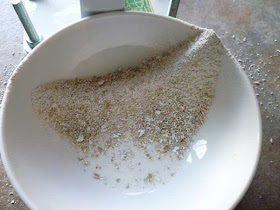Nils' Schöner's Sourdough Method for Rye
This blog entry is part 2 of the 'Tale of Two Sourdoughs' cycle, a comparison of two very different sourdoughs, one made with rye and the other made with wheat.
Part 1: Arva Flour Mill supplies my grain
Part 3: Laurel's Kitchen Bread Book's Whole Wheat Desem
One would be hard pressed to find a simpler sourdough method than that given by Nils Schöner in his book "Brot: Bread Notes From A Floury German Kitchen". Nils maintains that there is no need to keep both a rye and a whole wheat sourdough: if you keep a rye sourdough, it can easily be used to inoculate or build a wheat sourdough of any description, be it whole wheat or even a sourdough of bread flour. And the rye sourdough is remarkably easy to get going.
If my experience is the norm, I would wholeheartedly agree. Nils said that I might not see any fermenting activity until the third day. But I saw signs of fermenting from the very first day, and on the second day the signs were even stronger.
I would agree with him when he says that it takes a couple of refreshes before this sourdough is able to rise bread on its own in a timely manner. The wild yeast is in there, but it shares space with some lacto bacillus bacteria that give the sourdough its characteristic sour scent and flavour. This rye sourdough, by the time it is refreshed for the first time, has a very strong sour taste. I am thinking that as the yeasts build up, they will become stronger than the bacteria. But the environment will never be totally devoid of the bacteria, and this sourdough will remain a very acidic place for the wild flora to live.
Day 1, you grind the rye into flour, and use 25g of flour with 25g of water, and stir it into paste. You leave it overnight, covered, at room temperature.
Get some rye kernels from Arva Flour Mills
These rye kernesl look nice, don't they?
I'm guessing I'll need to grind twice as much grain by weight as what's needed in flour
Looks like you only need about 1/3 of a cup of rye kernels to grind up 25g of flour
Into the Grain Mill
Gee, that doesn't look like much
Milled Rye
Measure out 25g
Measure your water
Equal by weight rye flour and water
Mix it
Cover it
Day 2, you do the same thing, but add your 25g of flour and 25g of water to the 50g of mixture that you already have.
I'll grind up the same amount, about 1/3 c of rye kernels
And measure out what I require: the same amount, 25g
Equal weight in water
Mix it up
Now it's ready to add to yesterday's mixture
Both mixtures look the same: just that one is a day older
Mix it together
Label it
Already by the 11th hour of the 2nd day I'm seeing some fermentation bubbles
Day 3, now you can double the amount you add: grind up enough rye to make 50g of flour, and add that to 50g of water and the 100g of mixture you already have. Each day we are doubling how much we add.
Measure flour: 50g today
Measure water: 50g today
Mix it up and add it to yesterday's mixture
Day 4. Time to add 100g of rye flour and 100g of water to the 200g of mixture you already have.
Fermentation bubbles visible
Moonscape texture
Now I'm grinding up about a cup of rye kernels daily
Now I can see the rye kernels in the hopper
This time I grind up enough for 100g of flour
Equal amounts of water
Stir it all up
Larger container required
You can see here the level of the mixture when I finished mixing it, on the 4th day
Day5, Lots of fermenting action here today. We divide what we have in half, and use only one of the halves to add that amount of new flour and water back into the mixture. For me, I've got 190g of material, to which I add 95g of rye, and 95g of water. This is the first refresh.
Yes, we have definite fermenting action going on
But we don't need all of it anymore: measure it
now keep only half
grind up some more rye
And measure out how much you require
Mix it with equal amounts of water
This is the first 'Refresh'
See the level at the end of day 5
Day 6, repeat yesterday's actions: toss away half of what you have, and add the same amount back with half rye flour and half water. Here I added 185g of flour, 185g of water to 270g of mixture. And this time, after I was finished mixing it up, I put the whole thing in a jar to be refrigerated and refreshed weekly.
Visible fermentation even from above
Pretty good rising ability
Mill some rye kernels
Measure some freshly milled rye flour
Measure some water
Mix it up: this is your second refresh
Now we can put it in a jar and refrigerate it
And now we can bake with it
usually using no more than a tablespoon or two to flour to make up a starter overnight
The first test loaf with the new sourdough was Nils' 60 percent rye with apple juice soaker. It only used 1 teaspoon of the sourdough, but boy was it good. So good, I made it again soon on the heels of the first loaf, so that my mother-in-law could try it.
The second test loaf was a pure experiment to make use of the sourdough discard. It was a rye, wheat and teff with sourdough, and it didn't rise all that well but was still edible.
This new sourdough is one I will try to keep going for as long as possible.



















































No comments:
Post a Comment